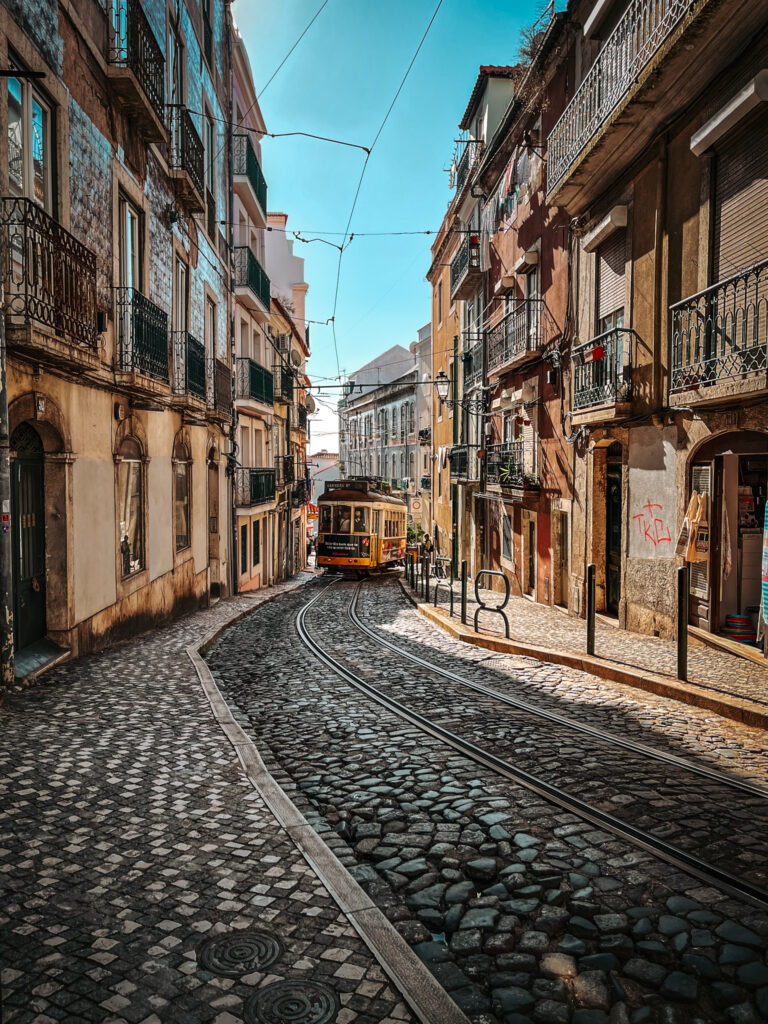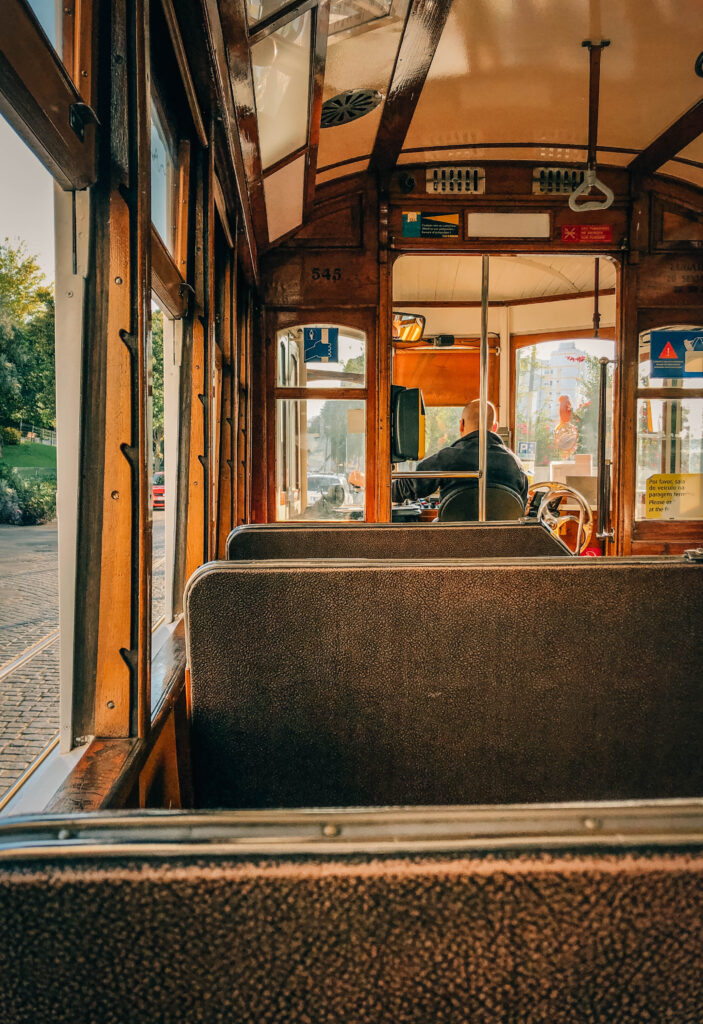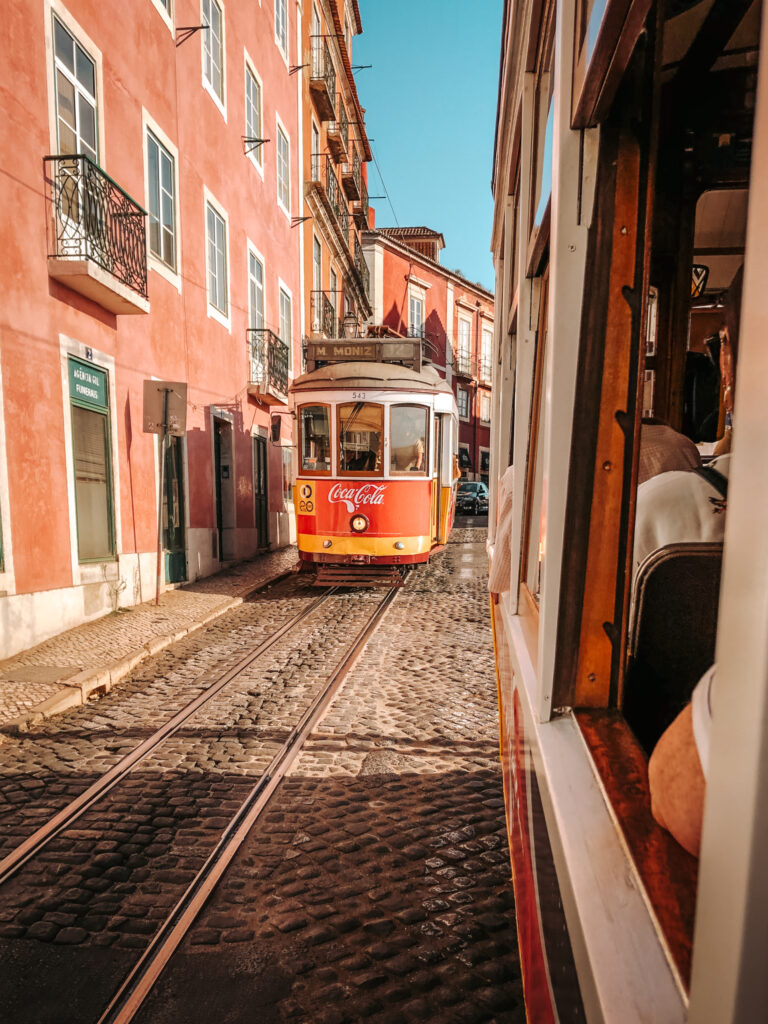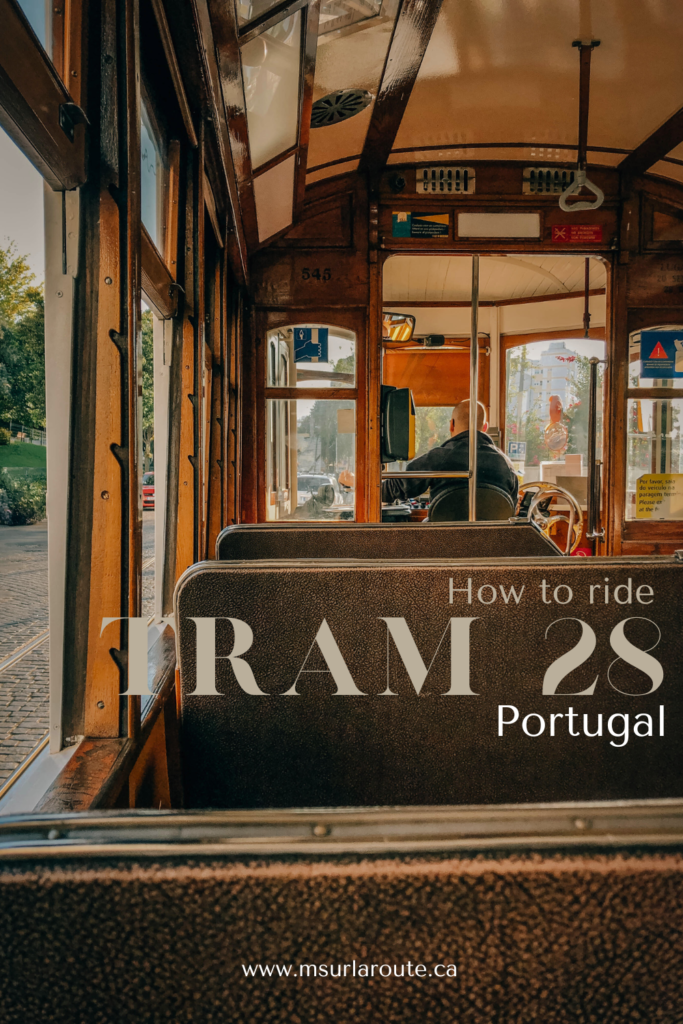Want to ride Tram 28 without the crowds? Then this blog post is for you! I share my 5 tips to ride Tram 28 like a pro: discover the ideal routes, learn pro techniques for securing a coveted seat, and master the art of avoiding long queues.
To ride, or not to ride, that is the question!
Lisbon’s iconic trams serve as both as beautiful backdrop and an essential mode of transportation in Lisbon. Their distinctive squeaks and rattles echo through the narrow streets of the city while the famous yellow trams have become emblems of the city. But Beyond their tourist allure, Lisbon’s trams are a lifeline for locals, offering convenient connections across the city’s sprawling terrain, including its notorious hills.
Riding Tram 28 in Lisbon is one of the most iconic things to do in the City, but it can also be a flop if not done right.
Keep Reading // 11 Amazing Things to do in Lisbon
But fear not, I have uncovered the secrets to enjoying this classic adventure to the fullest. Drawing from my own experiences, I share some tips and tricks to beat the crowds and savor every moment aboard these nostalgic trams.
So, is Tram 28 really worth the hype? The answer yes, but you need to do it right!

HERE ARE 5 TIPS TO RIDE TRAM 28 LIKE A PRO
… BUT FIRST, SOME HISTORY
The Lisbon tram system entered service on 17 November 1873 as a horsecar line. At the time, the “trams” were only available in the flat parts of the city where horses were capable of hauling their passenger loads. However, if you know anything about Lisbon, you’ll know that it is nothing but flat…
Keep Reading // To learn why Lisbon as the nickname “City of Seven Hills” check out the blog post about 14 Things to Know Before Visiting Lisbon
To remediate this problem, the City Council proposed the use of funiculars : the first one came into service in 1884. This marked a significant milestones in the city’s transportation history.
In 1890, the first cable tram route was put into operation. This was a 1,7 kilometer route between Praça Camões to Largo da Estrela. This innovative technology offered an alternative to funiculars for navigating Lisbon’s longer and curved routes. A few years later, in 1901, Lisbon’s first electric tramway commenced operations. Within a year, all of the city’s routes had been converted to electric traction.
But what about route 28?
Trams 28 dates back to 1914 when horse drawn carriages were replaced by the now iconic yellow trams. If some lines use newer trams cars, Tram 28 looks very much the same as it at the beginning of the 20th century with wooden floors, timber window frames and yellow bodies.
But why is this route so popular? The 7km long route passes through the districts of Graça, Alfama, Baxia, Chiado, Santa Catarina and Estrela : basically all the popular districts of Lisbon. It takes about 50 minutes to travel the entire route between Largo do Martim Moniz and Campo Ourique.

TIP 1: DON’T WAIT TO GET ON THE TRAM TO BUY YOUR TICKET
To save both time and money, and to avoid feeling like everyone is annoyed with you, I highly recommend purchasing your tickets in advance. Of course it is possible to buy your ticket on the tram itself for a fee of €3 in cash. But imagine if all the passengers did that… what a hassle.
Instead, consider buying a Viva Viagem card from any metro station, allowing you to preload your tram journeys beforehand. For maximum convenience and value, adding a 24-hour unlimited pass to your card for just €6.60 provides unlimited access to all public transport for a full day, including the picturesque Elevador de Santa Justa and Elevador da Glória funiculars.
Alternatively, if you anticipate using public transport less frequently, you can opt for the “zapping” option, loading a cash balance onto your card at €1.65 per tram ride. All you need to do is tap your card when you get in the tram.
If you have the Lisbon Card public transportation is free, including Tram 28.
TIP 2 : DON’T GO AT THE SAME TIME AS EVERYONE ELSE
It’s 10am on a Saturday, should I ride tram 28? Absolutely not!
Fun Fact // Did you know that it is estimated that Tram 28 transports around 4,5 million passenger every year? But get this… each tram can sit 20 people and about another 25 standing. If you do the math, that means very cramped cars.
Knowing when to ride Tram 28 is a bit complicated because peak time is anytime between 9am and 7pm. And conductors often skip stops when there is no more space for additional passengers…
During peak time, particularly at Praça Martin Moniz, it can take an hour or more to get in, particularly in the busy summer season.
So when should you get on? Try early in the morning, before 9am or at the end of the night around 9pm.


TIP 3: GO THE OPPOSITE WAY AS EVERYONE ELSE
To maximize your chances of securing a seat on the often crowded trams in Lisbon, consider boarding at one of the start or end stops of the line, such as Campo de Ourique in the west or Martim Moniz in the Alfama district. Riding the full route without hopping on and off in the middle allows you to experience all the sights.
However, as I’ve mentioned above, Praça Martin Moniz can get extremely busy since it’s right in the middle of the city center. That is particularly true in peak tourist season where the wait time can be more than an hour.
For that reason, I highly recommend riding in the opposite direction. Rather than waiting in endless lines at Martim Moniz, start your journey at the other end, in Campo de Ourique. By starting in Campo de Ourique, a square in a less touristy neighborhood of Lisbon, you’ll be able to get a seat next to the window and enjoy the entirety of the Tram 28. Get there by taxi, on the #25 tram, or enjoy the 45-minute walk from Chiado.
Warning // Tram 28 is renowned for being a hotspot for pickpockets. Make sure you hold on to your belonging, especially if you are doing the ride standing.
TIP 4 : KNOW WHERE TO SIT
When boarding the tram, choose your seat strategically to optimize your sightseeing experience. If you’re starting your journey at the Martim Moniz stop in Alfama, opt for the left-hand side of the tram to enjoy panoramic views of the oceanfront and key tourist attractions as you travel downtown.
On the other hand, if your journey begins at the Campo Ourique stop in the west, select the right side for the best sightseeing opportunities. Keep in mind that the seats on the right side of the tram are typically singles rather than benches. If you’re traveling with friends or family, sitting on the right may mean sacrificing sitting together as a group.
TIP 5: WHEN ALL ELSE FAILS, TRY ANOTHER ROUTE
If all of the tips above have not worked, consider opting for tram 12 instead of the iconic tram 28. Both trams use charming historic trams carts, but the number 24 typically has shorter queues and more available seats, allowing for a more relaxed journey.
Tram 12 follows a similar route to tram 28, but does not cover as much ground. Instead of the 7km route of Tram 28, Tram 12 covers only 4km and the entire route takes around 20 minutes.
Still, tram 12 offers a delightful journey along some of the same tracks in Alfama as the famed tram 28, making stops at iconic landmarks such as São Jorge Castle, Miradouro de Santa Luzia, the Se Cathedral, and more.

READ THESE POSTS BEFORE VISITING LISBON!
LISBON GUIDES | 11 Amazing Things to do In Lisbon; 14 Things to Know Before Visiting Lisbon; How to make the best of your visit to Belém; 1 day, 3 castles: How to make the best of your day in Sintra; Where to Stay in Lisbon?
LISBON PHOTOS | 30 amazing photos of Lisbon
THE REST OF PORTUGAL | 11 amazing things to do in Porto; 9 amazing things to do in Lagos
PIN FOR LATER



Follow me on Instagram!
Planning a road trip through Alberta? Steal my 6-day itinerary, it’s packed with epic views, and once-in-a-lifetime stops. 🚗🏔️
I flew in and out from Calgary and explored the Rockies for a little less than a week. Here’s how it all breaks down:
📍 Day 1 – Kananaskis
Quiet hikes, glamping, and peaceful mountain vibes far from the crowds
❄️ Day 2 – Icefields Parkway + Columbia Icefield Adventure
One of the most scenic drives in Canada + a glacier walk you’ll never forget
🦌 Days 3 & 4 – Jasper National Park
Canyons, lakes, wildlife, and so many underrated gems
🏞️ Days 5 & 6 – Banff National Park
Classics for a reason!
💾 Save this post if Alberta’s on your bucket list — and head to the blog for the full itinerary, map, and all my tips!
Which stop would you be most excited to visit?
🇫🇷 La version française est dans les commentaires! ⬇️
#AlbertaRoadTrip #TravelAlberta #ExploreCanada #Kananaskis #ColumbiaIcefield #IcefieldsParkway #JasperNationalPark #BanffNationalPark #CanadaItinerary #AlbertaAdventure #RockyMountainRoadTrip

I’m manifesting that by the end of today…
the person you send this Reel to will say:
“Okay fine, let’s book it.”
Back Forty Glamping =
✨ Beautiful domes
🔥 A private hot tub with nature views
🌲 A forest sauna you will stay in too long
🌌 And the kind of stargazing that makes your phone camera give up
This place is made for weekend escapes, slow mornings, and that “can we just stay one more night?” kind of feeling.
💫 Send this to your go-to adventure buddy — and let the manifesting begin.
Who would you bring with you?
🇫🇷 La version française de ce texte se trouve dans les commentaires.
*invited stay*
#BackFortyGlamping #OntarioGetaways #GlampingCanada #UniqueStaysOntario #ManifestThatTrip #ExploreOntario #ForestGetaway #WeekendEscapeVibes

Banff gets all the attention… but if you’re craving something quieter and just as beautiful, head to Kananaskis. 🏔️✨
This lesser-known corner of the Rockies is packed with stunning trails, peaceful drives, and mountain views you don’t have to share with busloads of tourists.
Here’s how to spend 24 hours in Kananaskis:
• Stay in a cozy mountain cabin at Skyridge Glamping
• Grab coffee in Canmore
• Hike to the unreal turquoise waters of Grassi Lake
• Drive the wild and winding Smith-Dorrien Trail
• Chase waterfalls at Troll Falls
• Stop at Mt. Lorette Pond for a quiet moment by the water
💾 Save this itinerary if you’re planning an Alberta road trip and tag someone you’d love to bring along.
What would you add to a perfect day in Kananaskis? Drop your recs below ⬇️
🇫🇷 La version française de ce texte se trouve dans les commentaires.
#Kananaskis #ExploreAlberta #HiddenGemsCanada #AlbertaItinerary #CanadianRockies #GrassiLake #TrollFalls #SkyridgeGlamping #SmithDorrienTrail #NatureEscapeCanada #glacierviewsandgoodvibes

If you’re craving a summer getaway that’s equal parts charming, relaxing, and lowkey underrated… meet Southampton. 🌊☀️
Just down the road from Sauble Beach, this little Lake Huron town has everything you need for the perfect beach day : cozy stays, great brunch, boutique shopping, and yes, one of the best sunset spots in Ontario.
📍 Stay: a retro-modern motel with a sauna and serious design goals
🍳 Eat: local brunch spots that fill up for a reason
🏖️ Do: shop small and local on High Street and have the perfect beach day (swings included!)
🌅 End the day: with your toes in the sand watching that golden hour roll in
💾 Save this if you’re looking for a new summer escape in Ontario and tag someone who’s overdue for a road trip.
🇫🇷 La version française de ce texte se trouve dans les commentaires
*Invited stay*
#SouthamptonOntario #OntarioBeachTowns #ExploreOntario #LakeHuronSunset #HiddenGemsOntario #SummerInOntario #BeachWeekendVibes #OntarioGetaways #TravelOntario

Looking for wide beaches, peaceful trails, and sunsets that make you stop mid-sentence? ☀️🌊
Pinery Provincial Park has all of that, and it’s one of the most beautiful places to slow down in Southern Ontario.
Located on the shores of Lake Huron, Pinery is perfect for a day trip or a weekend escape filled with sand, sun, and forest walks.
✨ Why visit Pinery this summer:
• 10 km of sandy beaches with warm, swimmable water 🏖️
• Some of the best sunsets in Ontario (seriously) 🌅
• Easy, photogenic trails like Cedar, Nipissing & Riverside 🌲
• Paddle or spot turtles along the Old Ausable Channel 🐢
• Camp, bike, picnic, or just… do nothing (it’s that kind of place)
It’s the kind of park that makes summer feel slower and better.
💾 Save this guide for your next Ontario park day.
Have you been to Pinery? Drop your favourite trail or memory below ⬇️
🇫🇷 La version française de ce texte se trouve dans les commentaires
#PineryProvincialPark #OntarioParks #LakeHuronVibes #ExploreOntario #OntarioBeaches #SummerInOntario #HiddenGemsOntario #BeachHikeRepeat #NatureEscapeCanada

